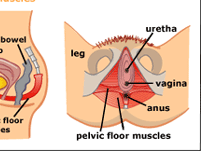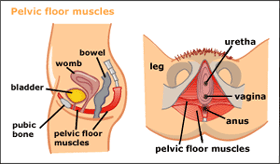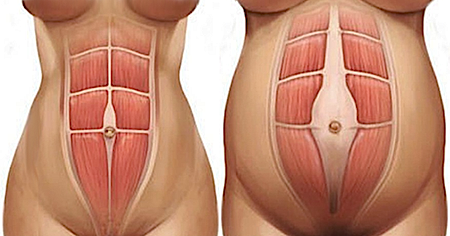
Pelvic Floor
Pelvic floor? Kegels? I’m already confused… what exactly ARE THEY?
The pelvic floor muscles (also known as Kegels) are those that sit between the pubic bone and the tailbone. The muscles that sling around the passageways (urethra, vagina, and rectum) and help to keep us continent.
 The pelvic floor is responsible for controlling the opening and closing of the passageways, so that we can control continence by deciding when we want to open our bladders and bowels.
The pelvic floor is responsible for controlling the opening and closing of the passageways, so that we can control continence by deciding when we want to open our bladders and bowels.
They also help to support the pelvic organs and prevent prolapse.
To activate these muscles try the following cues:
- try to imagine stopping the flow of urine
- try to imagine holding in wind
- try to imagine squeezing and holding a tampon in
When you are trying to activate them make sure you aren’t:
- holding your breath
- squeezing your butt cheeks/legs/tummy muscles
- straining or bearing down
When you’re doing a pelvic floor contraction, it should be a secret! No-one should be able to see that you’re doing it. So no breath holding, butt squeezing or face grimacing!
RECOMMENDED : IMPORTANT THINGS TO KNOW WHEN YOU ARE PREGNANT
Where should I get started?
A good way to start is to squeeze and hold your pelvic floor for 5 seconds, relax for 5 seconds and then repeat for 5 sets.
You can also try “quick flicks” where you contract then relax your muscle 15 times as quickly as you can. Remember to relax completely in between each contraction!
Try these exercises 2-3 times per day in lying or sitting positions to start with.
How will I remember to do them?
Try to do them when you’re…
- stopped at the traffic lights
- finishing on the toilet
- in the shower
- talking on the phone
- lying in bed
The current statistics tell us that 1 in 3 women who have ever had a baby will wet themselves and 1 in 2 women who have ever had a baby will experience prolapse.
The evidence tells us that pelvic floor strengthening is a successful treatment to manage these conditions.
So let’s spread the word and get started today!
Tell your girlfriends, sisters, mothers all about it and start strengthening these muscles!
As an extra bonus, pelvic floor strength has been shown to reduce the time spent in second stage of labour, aid recovery in the post-natal period and improve sexual function.
If you ever needed an excuse to start your pelvic floor exercises then there it is!
xo Physio Laura
Author: My name is Laura Callea, aka Physio Laura. I am a women’s health physiotherapist who is passionate about working with pregnant and postpartum women to help them stay strong and healthy throughout the motherhood journey.
Facebook: facebook.com/physiolaura Instagram: @physiolaura Website: www.physiolaura.com
RECOMMENDED – Heartburn and Acid Reflux During Pregnancy
Follow Pregnancy & Beyond on Instagram, Facebook and Twitter





Thank you for the info!!